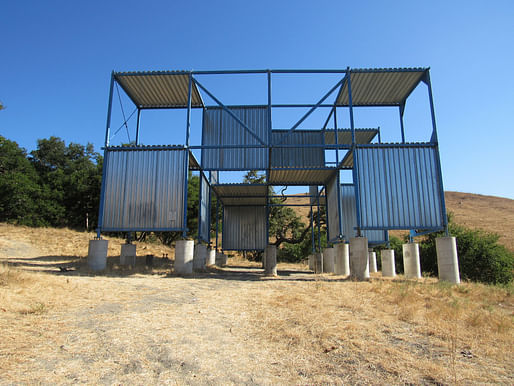

Tucked away in the hills of San Louis Obispo sits a nine-acre collection of experimental structures. The mishmash of unconventional architecture, around 15 projects in total, has become known as the Architecture Graveyard and is a popular hiking area of the Poly Canyon.
The site's actual name is the Experimental Structures Facility and it has been used from 1963 to 2009 by the nearby California Polytechnic State University, San Louis Obispo, to invite architectural, engineering, and design students to build large-scale structures ranging from a chimneyed greenhouse to a geodesic dome. It is also home to the prestigious annual Design Village competition, in which teams of first-year students build and inhabit temporary structures in the canyon for the entirety of a weekend.
↑ This structure was built in 1964 as an experimental house with a steel frame and wood infill. The name comes from the fact that the building is on an eight by eight module vertically and horizontally in order to avoid cutting any lumber. An addition was constructed at 45° to the original layout.
Student caretakers used to maintain the area, living on site in some of the permanent structures like the Modular House pictured above, which housed both the site's first and last caretaker. But, since 2009, their presence has been absent due to the underground electricity system being deemed unsafe. As a result, the area has been ravaged by vandalism in recent years, threatening the structures that have stood there for generations.
The school is currently taking certain measures to rehabilitate and repair some of the structures. The previously mentioned Modular House was recently renovated as part of a senior project and the school has been organizing Canyon Days in which volunteers help with painting, demolition, construction, landscaping and overall clean-up.
Read on to learn more about some of the student-built structures.
↑ The Shell House, built in 1963, is the oldest structure still existing in the canyon. The Shell House's distinctive roof was created by putting up a center pole with cables hanging down, then spot welding on wire mesh, then a mortar-like substance (shotcrete) was sprayed onto the mesh, and then the pole was removed.
↑ Although not finished, the plans of the Greenhouse, built between 1983-1989, were quite innovative with the intention to install an automatic watering system and venting system, along with more plant beds to innovate the idea of a standard greenhouse. The black grate on the back was meant to store water that would be heated by the sun. The heat would then be released in the evening to maintain the same temperature throughout the day. The stack ventilation allows heat to rise then the catchers rotate to optimize ventilation.
↑ The Tensile Structure, built in 2002, with the purpose of providing shade for the annual design village project held in the canyon every year. The 12 footings that hold the cables all connect underground for strength and stability.
↑ The Blade Structure, first constructed in 1963, was one of the first structures on campus to test post-tensioning methods. After many years of deterioration, the blade structure was reconstructed in 2003 by students with modified calculations to abide by updated building codes and create a more structurally sound project.
↑ Before the Fratessa Tower was built in 2004, the Hydraulic Tower stood in its place. This structure used natural air circulation to support its own weight.
↑ The Fratessa Tower, built in 2004, replaced a previous observation tower whose structural support was based upon an incompressible water column. Due to leakage issues this structure was decommissioned, however the new tower was built on original foundations
↑ Design Village, 2017.
3 Comments
I spent lots of time out in Poly Canyon.
I propose that Elon Musk fix the electricity so student caretakers can resume their roles. He’s got lots of experience with underground work lately, yes?
That's a nice collection and place, it looks like.
Block this user
Are you sure you want to block this user and hide all related comments throughout the site?
Archinect
This is your first comment on Archinect. Your comment will be visible once approved.